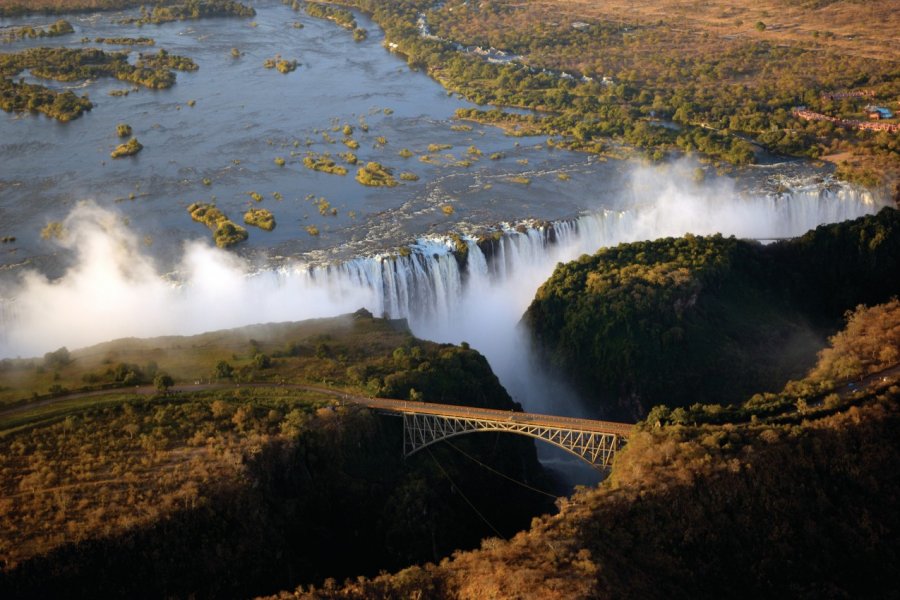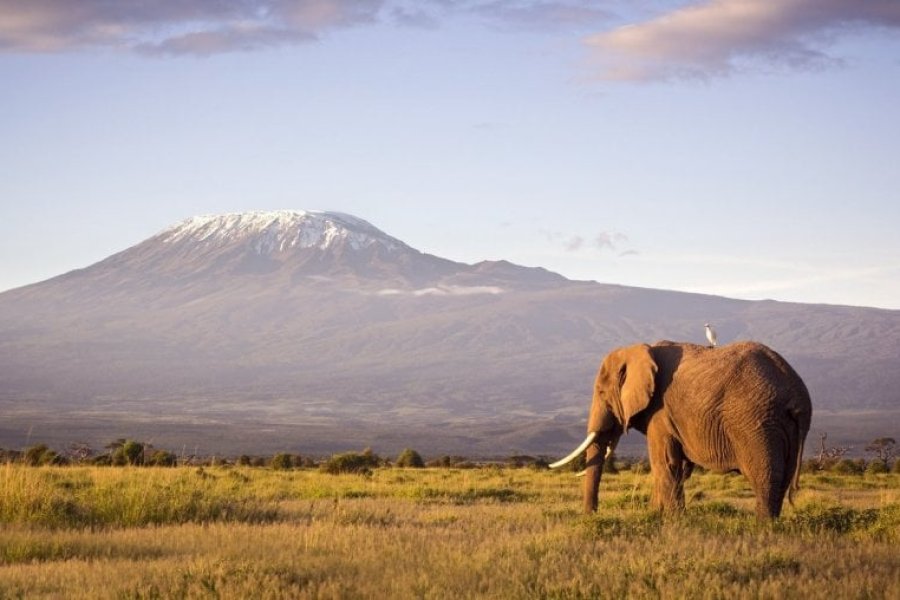Travel Guide Victoria Falls National Park
Find an accommodation
Advertising
At 103 meters high, Victoria Falls is twice as high as the famous American Niagara Falls and spreads its curtain of waterfalls over a distance of more than 1,700 meters. Their extremely powerful flow can reach, at the end of the rainy season, 545 million liters per minute. And the crash that they generate by rushing in a brutal way in the gorge is heard to several kilometers in the round, like the terrible roar of some infernal creature.. This fascinating place, the mist that escapes from it, the sound of the falling water, as well as the tropical forest that has developed around it, have for thousands of years intrigued the local populations, who have developed all sorts of beliefs and rituals around the falls that they call "Mosi-oa-Tunya", "the smoke that thunders". The mist can rise up to 400 m above sea level and can be seen up to 50 km away. It is possible to see a phenomenon as rare as strange: lunar rainbows, which appear above the falls on the evenings of full moon. One understands the astonishment and fascination of Livingstone when, in 1855, during one of his numerous expeditions in southern and central Africa, he discovered this jewel of nature... Surprised and attracted by a curious whitish cloud rising permanently above a tiny part of the forest, he probably asked the natives to lead him to the foot of this famous Mosi-oa-Tunya of which the Sebituane chief had told him. There, bathed by the spray projected above the fault and stunned by the incredible din resounding in the gorge, Livingstone had the revelation of one of the most extraordinary natural sites of all times, and, subjugated by so much majesty and splendor, he gave the falls the name of its queen: Victoria. After independence, during the hunt for colonial names, a group of opponents of the former white regime expressed the desire to give the falls back one of their original names: "Mosi-oa-Tunya". In the end, it was decided to leave the cataracts with their popular name, so as not to affect the growing flow of tourists and foreign exchange. The name Vic Falls was also retained for the tourist town that developed on the south side of the falls from 1905 onwards.Forming one of the most beautiful natural boundaries in the world, Victoria Falls is one-third Zambian territory and two-thirds Zimbabwean territory. This disproportion certainly explains why, for many years, Zimbabwe benefited more from the presence of the falls than Zambia. However, with the economic and political crisis that has persisted in Zimbabwe since the late 1990s, the trend has reversed considerably and Livingstone (in Zambia) now receives more tourists than Victoria Falls (in Zimbabwe). If possible, we recommend that you visit the two cities, which look very different, or at least take a day to see the falls from the Zimbabwean side. In addition to the attraction of the wonderful cataracts, the area has become a reference point for adventurers from all over the world, eager to practice extreme sports in an exceptional natural setting: bungee jumping, rafting, hiking, climbing, boating, etc.Zambian side. The Zambian side offers a relatively different panorama from the Zimbabwean side. Located at the end of the gorge of the falls and not so close, it offers a multitude of different panoramic views (and that is the point). In low water season, however, we don't recommend visiting this park if you have to choose just one, as the view is limited to a lot of bare rock; better to focus on the closer and more impressive Zimbabwean side. The main walking path runs along the cliff facing the falls with a dizzying passage on a metal footbridge (the knife-edge bridge) which ensures, from March to May, a memorable natural shower. A nice viewpoint on the river, often crowned with a rainbow, is also to be noted upstream from the falls. Then the route leads you through the woods to a viewpoint on the large border bridge that spans the fault at a height of 111 meters. You may be able to make out the yo-yo silhouettes of bungee jumpers in the distance. For another perspective, it is possible, but only on the Zambian side, to descend to the bottom of the gorge. From the entrance, follow the signs to the Boiling Pot, used by rafters as a starting point for their descent of the Zambezi River during the low water season. A colony of baboons lives on either side of this path and it can be quite impressive to walk through it, with large males sometimes sitting in the middle. Walk around them calmly, they are used to tourists! You will first climb some large stairs through a patch of primary tropical forest with its particular plant species, then continue carefully through the rocks. The descent and ascent are quite tiring, but the breathtaking view of the bridge and, with a little more effort, of the waterfalls that spill into the canyon, is worth it, the ideal being to bring a picnic. Some tour operators offer, in certain seasons, to approach the falls from below and swim in the river "under the spray".Finally, if you go around the end of the gorge, opposite the main path that faces the falls, you can discover the river flowing quietly just a few meters before plunging into its dizzying fall. A very nice place, ideal to rest at the end of the visit.Zimbabwean side. The Victoria Falls National Park covers 23 km2 and includes the cataracts and the ecosystem directly linked to it. Small walking paths and gentle promontories lined with small thorn bushes (to prevent the curious from getting too close to the edge) have been laid out along the rift and offer breathtaking views of the cascading waterspouts. Contrary to the Zambian shore, one can contemplate here the whole curtain of the falls (or, depending on the period, guess it through the spray) divided into five major cataracts: Devil's Cataract (30 m wide and 70 m high), Main Falls (1 km wide and 93 m high), Horseshoe Falls, Rainbow Falls (the highest, at 108 m) and Eastern Cataract (101 m high). At the end of the falls is the Danger Point (the dangerous point!) from where it is possible to observe the bubbling of the water in the bottom of the gorge. Then, the fault splits in two to let the river flow under the metal border bridge. Watered permanently by the projections of the falls, the vegetation which borders the rocky sides spreads out in a luxuriant mini-jungle, which is not without reminding the tropical forests of the center of Africa. There, in the middle of lianas, palms and exotic trees, baboons, thrushes, warthogs, cobes and harnessed guibs frolic, while butterflies and birds with shimmering colors fly in the ferns and ebony trees around...
Suggested addresses Victoria Falls National Park
Weather at the moment
Advertising
Organize your trip with our partners Victoria Falls National Park
Transportation
Book your plane tickets
Car Rental
Boat rental
Accommodation & stays
Find a hotel
Holiday rental
Find your campsite
Tailor-made trip
Immersion travel
Services / On site
Activities & visits
Find a doctor






